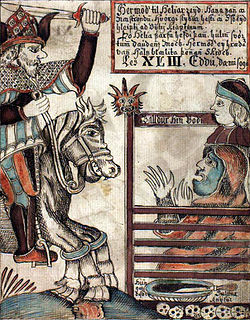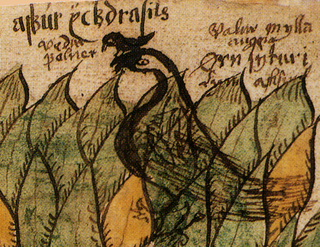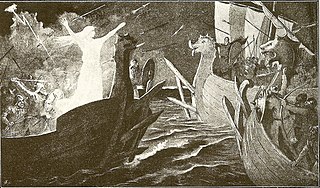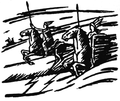
Bragi is the skaldic god of poetry in Norse mythology.

In Norse mythology, Valhalla is a majestic, enormous hall located in Asgard, ruled over by the god Odin. Chosen by Odin, half of those who die in combat travel to Valhalla upon death, led by valkyries, while the other half go to the goddess Freyja's field Fólkvangr. In Valhalla, the dead join the masses of those who have died in combat, known as Einherjar, and various legendary Germanic heroes and kings, as they prepare to aid Odin during the events of Ragnarök. Before the hall stands the golden tree Glasir, and the hall's ceiling is thatched with golden shields. Various creatures live around Valhalla, such as the stag Eikþyrnir and the goat Heiðrún, both described as standing atop Valhalla and consuming the foliage of the tree Læraðr.
In Norse mythology, Gungnir is the spear of the god Odin.

Sigrún is a valkyrie in Norse mythology. Her story is related in Helgakviða Hundingsbana I and Helgakviða Hundingsbana II, in the Poetic Edda. The original editor annotated that she was Sváfa reborn.

In Norse mythology, the einherjar are those who have died in battle and are brought to Valhalla by valkyries. In Valhalla, the einherjar eat their fill of the nightly-resurrecting beast Sæhrímnir, and valkyries bring them mead. The einherjar prepare daily for the events of Ragnarök, when they will advance for an immense battle at the field of Vígríðr.

In Norse mythology, Fólkvangr is a meadow or field ruled over by the goddess Freyja where half of those that die in combat go upon death, while the other half go to the god Odin in Valhalla. Fólkvangr is attested in the Poetic Edda, compiled in the 13th century from earlier traditional sources, and the Prose Edda, written in the 13th century by Snorri Sturluson. According to the Prose Edda, within Fólkvangr is Freyja's hall Sessrúmnir. Scholarly theories have been proposed about the implications of the location.

In Norse mythology, Gerðr is a jötunn, goddess, and the wife of the god Freyr. Gerðr is attested in the Poetic Edda, compiled in the 13th century from earlier traditional sources; the Prose Edda and Heimskringla, written in the 13th century by Snorri Sturluson; and in the poetry of skalds. Gerðr is sometimes modernly anglicized as Gerd or Gerth.

Hermóðr the Brave is a figure in Norse mythology, a son of the god Odin. He is often considered the messenger of the gods.

In Norse mythology, Ýdalir ("yew-dales") is a location containing a dwelling owned by the god Ullr. Ýdalir is solely attested in the Poetic Edda, compiled in the 13th century from earlier traditional sources. Scholarly theories have been proposed about the implications of the location.

In Norse mythology, Óðr or Óð, sometimes anglicized as Odr or Od, is a figure associated with the major goddess Freyja. The Prose Edda and Heimskringla, written in the 13th century by Snorri Sturluson, both describe Óðr as Freyja's husband and father of her daughter Hnoss. Heimskringla adds that the couple produced another daughter, Gersemi. A number of theories have been proposed about Óðr, generally that he is somehow a hypostasis of the deity Odin due to their similarities.

In Norse mythology, Surtr is a jötunn. Surtr is attested in the Poetic Edda, compiled in the 13th century from earlier traditional sources, and the Prose Edda, written in the 13th century by Snorri Sturluson. In both sources, Surtr is foretold as being a major figure during the events of Ragnarök; carrying his bright sword, he will go to battle against the Æsir, he will do battle with the major god Freyr, and afterward the flames that he brings forth will engulf the Earth.
In Norse mythology, Róta is a valkyrie. Róta is attested in chapter 36 of the Prose Edda book Gylfaginning, where she is mentioned alongside the valkyries Gunnr and Skuld, and the three are described as "always [riding] to choose who shall be slain and to govern the killings." Otherwise, Róta appears in two kennings, one by Egill Skallagrímsson and one by Hallfreðr vandræðaskáld. Theories have been proposed about the possible appearance of Róta in Gesta Danorum and the meaning of her name.

In Norse mythology, Veðrfölnir is a hawk sitting between the eyes of an unnamed eagle that is perched on top of the world tree Yggdrasil. Veðrfölnir is sometimes modernly anglicized as Vedrfolnir, Vedfolnir or Vethrfolnir.
In Norse mythology, Glasir is a tree or grove, described as "the most beautiful among gods and men", bearing golden red leaves located in the realm of Asgard, outside the doors of Valhalla. Glasir is attested in the 13th century Prose Edda book Skáldskaparmál where it receives three mentions, one of which mentions its location and all of which focus on the golden leaves of the tree. Glasislundr appears in the Poetic Edda poem Helgakviða Hjörvarðssonar.

Þorgerðr Hǫlgabrúðr and Irpa are divine figures in Norse mythology. They appear together in Jómsvíkinga saga, Njáls saga, and Þorleifs þáttr jarlsskálds. Irpa’s name does not appear outside of these four attestations, but Þorgerðr also appears in the Prose Edda book Skáldskaparmál, Færeyinga saga, and Harðar saga ok Hólmverja and is mentioned in Ketils saga hœngs.

In Norse mythology, Herfjötur is a valkyrie. Herfjötur is attested as among the 13 valkyries listed in the Poetic Edda poem Grímnismál, and in the longer of the two Nafnaþulur lists found in the Prose Edda.
Gunnr is an Old Norse term meaning "battle". It is the name of a valkyrie in Norse mythology, and was also used as a feminine given name. The modern forms Gun and Gunn remain in use as a feminine given name in Scandinavia. The word is from Proto-Germanic *gunþiz, which is a common element of Germanic names not only in North but also in West Germanic, as second element especially frequent in feminine names, as first element also in masculine names.



















